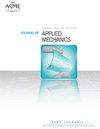通过局部截面的综合修正来重塑锥形结构的双稳性和多稳性
IF 2.8
4区 工程技术
Q2 MECHANICS
引用次数: 0
摘要
多稳态结构可以在没有附加载荷的情况下保持多个稳态。然而,多稳定结构中几何非线性和材料非线性的存在增加了其优化设计的复杂性和难度。本文提出了一种通过局部截面修正来实现圆锥结构多稳定性的新方法。在此基础上设计了一个变截面圆锥多稳结构。建立了考虑非线性大变形力学和橡胶材料超弹性的有限元模型,分析了橡胶材料的多稳态特性,并进行了实验验证。分析了截面几何参数(厚度、宽度、位置)对多稳定性(数量、分布和断裂阈值)的影响。通过局部加固,可以有效地利用稳态数来重新设计结构的多稳态特性。与原锥形结构相比,力-位移曲线的准零刚度区可延长61.7%。此外,优化后的QZS结构允许在强制振动下主动设计阶梯式动态响应。本文章由计算机程序翻译,如有差异,请以英文原文为准。
Reshape of the bistable and multistable properties of conical structures through integrated modification of local cross-section
Multistable structures can maintain multiple steady states without additional loads. However, the presence of geometric and material nonlinearities in multistable structures adds complexity and difficulty to their optimal design. In this paper, a novel method is proposed to achieve multistability in conical structures by local cross-section modification. A conical multistable structure with varying cross-section is designed based on this method. The finite element model considering the nonlinear large deformation mechanics and rubber material's hyperelasticity was established for analyzing the multistable properties and meanwhile verified by experiments. The influence of geometric parameters of the cross-section (thickness, width, position) on the multistabilities (number, distribution, and snapping threshold) was analyzed. The steady-state number can be effectively used to redesign the multistable properties by local reinforcement. It is also observed that the quasi-zero stiffness region of the force-displacement curve can be extended by 61.7% compared to the original conical structure. Moreover, the optimized QZS structure allows for an actively-designable stepped dynamic response under forced vibration.
求助全文
通过发布文献求助,成功后即可免费获取论文全文。
去求助
来源期刊
CiteScore
4.80
自引率
3.80%
发文量
95
审稿时长
5.8 months
期刊介绍:
All areas of theoretical and applied mechanics including, but not limited to: Aerodynamics; Aeroelasticity; Biomechanics; Boundary layers; Composite materials; Computational mechanics; Constitutive modeling of materials; Dynamics; Elasticity; Experimental mechanics; Flow and fracture; Heat transport in fluid flows; Hydraulics; Impact; Internal flow; Mechanical properties of materials; Mechanics of shocks; Micromechanics; Nanomechanics; Plasticity; Stress analysis; Structures; Thermodynamics of materials and in flowing fluids; Thermo-mechanics; Turbulence; Vibration; Wave propagation

 求助内容:
求助内容: 应助结果提醒方式:
应助结果提醒方式:


